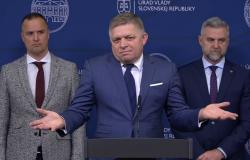Even during Easter, the Kremlin continued its intensive strikes on Ukrainian energy targets. Hundreds of thousands of people remained without electricity, a week earlier there were even a million and a half. The country’s largest private power company, DTEK, said over the weekend that five of its six power plants had been damaged or destroyed in the past two weeks.
Most of the damage concerns devices that have already been affected. “Some of the units that were commissioned two months ago are gone,” said company head Dmytro Sacharuk. “We had roofs redone, transformers installed, turbines and generators repaired. Now it’s all in ruins,” he added. During the rocket and drone attacks, gas storage facilities were also destroyed, the transmission system was disrupted and hydroelectric plants were also hit, raising fears of an ecological disaster.
Russia wants to seize the opportunity
Further repairs will cost at least hundreds of millions of dollars, and there are growing doubts in the country about the usefulness of such investments. The question is why Russia is attacking infrastructure so hard only in the spring when it would cause even more damage in the winter. It is possible that they see a unique opportunity at a time when Ukraine is deprived of Western aid and is forced to economize on military material.
“This encourages Russia and may have been a factor contributing to the current increase in airstrikes,” Aura Sabadus, an expert on Eastern European energy, told the American think tank Atlantic Council. “If Ukraine’s air defenses are further depleted, there can be no doubt that Russia will seek the complete destruction of the country’s civilian energy infrastructure,” she added.
The situation, where conjectures in the US Congress have been blocking further funding for Ukraine for months, can also threaten developments directly on the front. Zelenskyy claims that the Kremlin plans to launch a new major offensive in May or June, when the weather will be favorable and the land will dry out in the region.
The president declared that the situation on the front has stabilized for the moment and is better than two or three months ago, but according to him, the country needs to properly prepare for another Russian strike. “I’m saying we need help now,” the West called for more weapons. He emphasized that Ukraine primarily needs more Patriot air defense systems and artillery.
“Ukraine is currently preventing Russian forces from making significant tactical gains along the entire frontline, but continued delays in US security assistance are likely to increase the threat to Russian operational success,” the US-based Institute for the Study of War (ISW) said in its analysis. At the same time, the Institute warns that Russian forces will now most likely try to continue their attacks regardless of the current adverse terrain conditions in order to take advantage of the opponent’s lack of material.
Zelensky signed the law on mobilization
Kyiv is thus all the more dependent on supplies from Europe. Last year, the twenty-seventh promised him a million pieces of artillery ammunition by the end of March. However, everything indicated that due to stalled production, only about half of the plan would be fulfilled. In the meantime, the so-called Czech initiative has started, where Western countries agree to buy up to 1.5 million units abroad. According to some sources, the first batch could arrive in Ukraine this month, although earlier there was talk of June. If these reports are true, it will allow Kiev to make greater use of current supplies to repel the enemy.
However, the lack of weapons and ammunition is not the only problem of the Ukrainian forces. Another is the personnel shortage. Kyiv stated in December that up to half a million people would need to be mobilized. However, the Commander-in-Chief of the Ukrainian Armed Forces, Oleksandr Syrskyi, said a few days ago, without elaborating, that in the end significantly lower numbers would be enough.
“We expect to have enough people capable of defending our homeland. I’m not only talking about the mobilized, but also about the volunteers,” he told the Ukrinform agency. At the same time, there has been talk of problems with recruiting more Ukrainians into the fight for many months. At the same time, the public has a relatively high level of understanding for those who are hiding from the mobilization, according to the current survey, 54 percent of the population understands them.
On Tuesday, Zelensky signed the law on mobilization, which lowers the age of entry into service from 27 to 25. At the same time, critics argued that sending younger generations to the front would be suicide for the country’s further development.
Units fill their own gaps
The New York Times recently reported that many personnel-starved Ukrainian units, which consider the current recruitment system dysfunctional, have instead launched their own campaign in an attempt to attract new fighters. To do this, they use billboards, social networks and regular recruitment websites, some of which now have a special section for army ads.
“These campaigns are much more effective because we get exactly the people we need,” Dmytro Kozyatynskyj, a combat medic turned recruiter for the Da Vinci Wolves battalion, originally the paramilitary wing of the extremist Right Sector, told the paper. Unit commanders complain that those officially mobilized are often too old, in poor health and lack motivation. The mobilized, on the other hand, fear that they will be sent to the front without adequate training. Targeted campaigns offer candidates specific positions suitable for them.
Experts and some politicians point out that Ukraine apparently overslept when preparing defensive positions and did not build sufficient fortifications for a possible Russian operation. The Ukrainians failed to break through the Russian lines during last year’s counteroffensive, and now there are doubts about whether they will be as well prepared themselves.
“We started building and rebuilding the defensive fortifications only on March 1,” the website Politico quoted Kharkiv Oblast chief Oleh Synjehubov as saying, unable to say when the work would be completed. “The fortifications have a complex purpose and will consist of barriers and minefields,” he explained. The question, according to the website’s sources, is whether Ukraine has enough mines.
A question mark hangs over the Russian mobilization
The success of the Russian operation will of course also be determined by the readiness of the aggressor. The country has long been rumored to have ramped up war production, with CNN citing Western news sources reporting that it is now producing 250,000 pieces of artillery ammunition per month. It is said to be able to consume five to ten times more than the defenders. However, the replacement of tanks and armored vehicles apparently remains a bigger problem for Moscow.
The question is also whether it has enough personnel for a large operation. The British Ministry of Defense claims in a recent report that the Kremlin manages to recruit 30,000 people every month, a pace that also matches previous claims by Ukrainian military intelligence. “Russia may very likely continue to absorb losses and attacks to weaken Ukrainian forces,” the British report said.
At the same time, it was assumed that President Vladimir Putin would have a freer hand in this regard after his re-election. Mobilization is a sensitive topic, having previously led to the defection of hundreds of thousands of Russians, and the regime fears public protests. The Kremlin therefore now tried to rope in volunteers, including immigrants from Central Asia.
On the last day of March, the president signed a decree on the conscription of 150,000 conscripts as part of the regular spring campaign. The Ministry of Defense assured that they would not be sent to the front. Shortly before the terrorist attack in Moscow, the Russian media speculated about a plan for a new wave of mobilization, which will aim to recruit up to 300,000 people. It is now unclear whether Putin will reconsider his plans due to the action claimed by the Islamic State, but the Kremlin is trying to pin it on Ukraine.
Tags: Russians destroying Ukraines energy industry Kyiv afraid ground action
-






